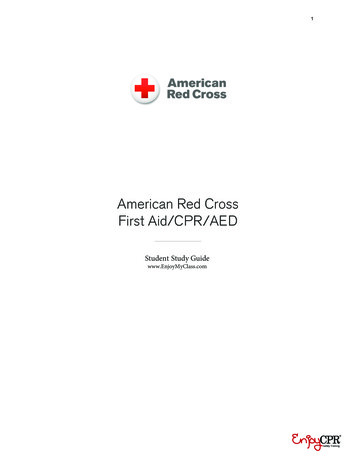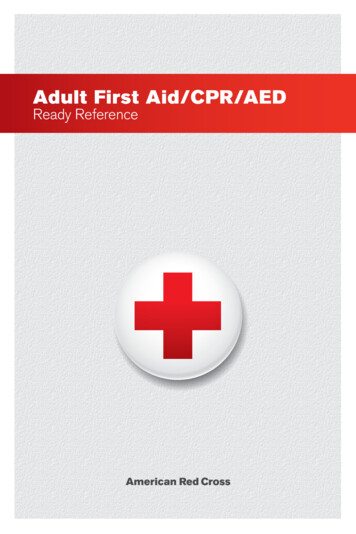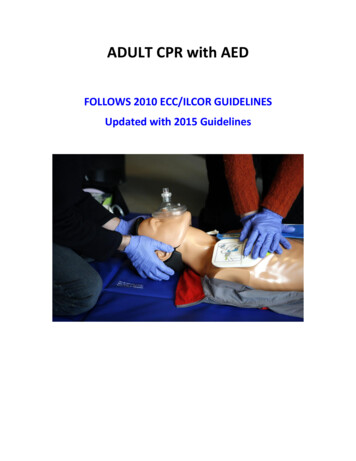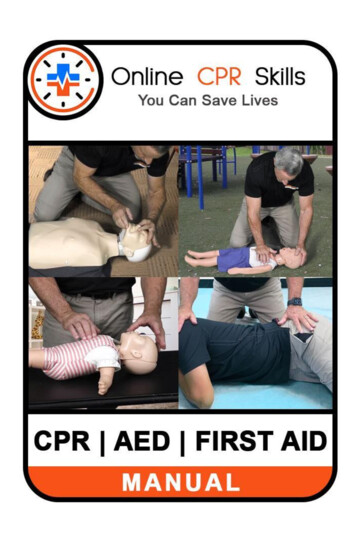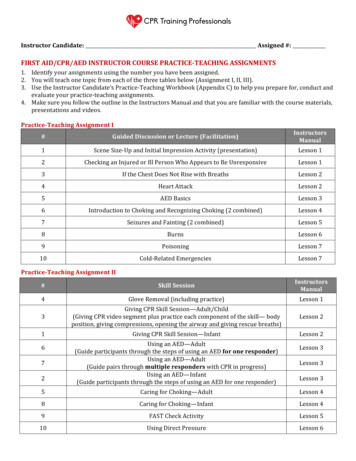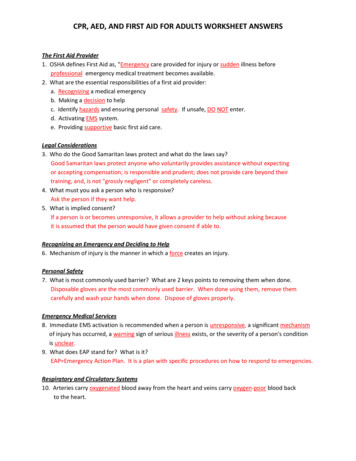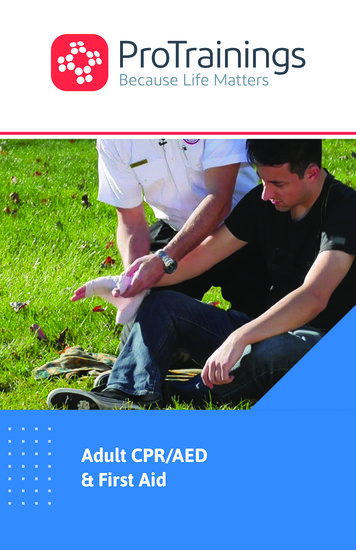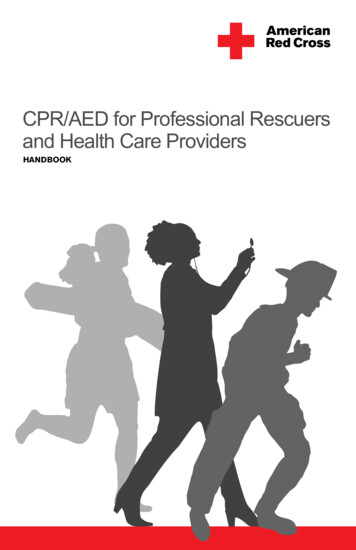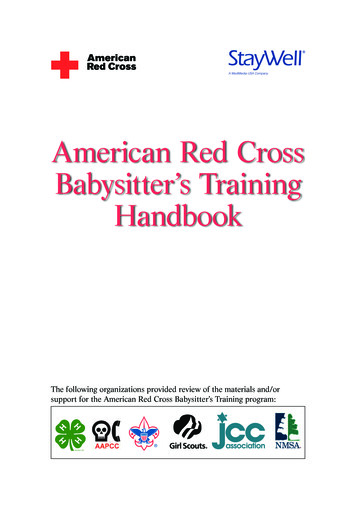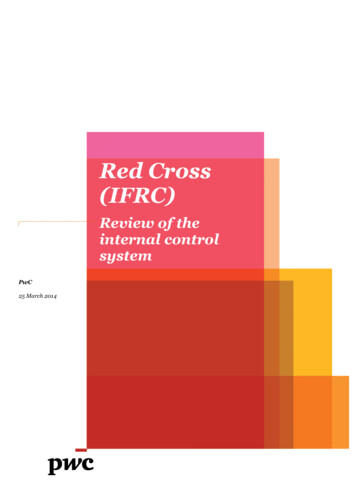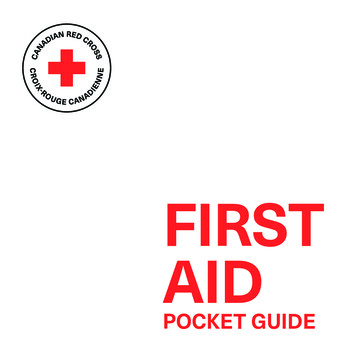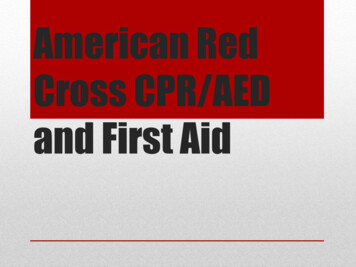
Transcription
American RedCross CPR/AEDand First Aid
10 participation points per day 30 points for notes 2 tests: 1 demonstration 15 points 1 paper assessment 30 pointsOverview of points
We will be working with expensive equipment this week Dummies AED’s Babies If your group is not treating the equipment properly Lose all participation points for the day Automatic detentionRules
900,000 people in the US die each year from some formof heart disease. Heart disease is the number one cause of death in thiscountry. Unintentional Injury (accidents) causes the mostchildhood deaths in the US.Before Giving Care
4 Steps: Recognize that an Emergency ExistsDecide to ActActivate the EMS SystemGive Care Until Help Takes OverYour role in the EMSsystem
Once you recognize that an emergency has occurred, youmust decide how to help and what to do. The most common factors that keep people fromresponding are: Panic or fear of doing something wrongBeing unsure of the person’s condition and what to doAssuming someone else will take actionType of injury or illnessFear of catching a disease or being suedBeing unsure of when to call 911 or the local emergency #Deciding to Act
The most common germs are bacteria and viruses. Bacteria can live outside of the body and do not depend onother organisms for life Infections caused by bacteria can be treated with antiobiotics. Viruses depend on other organisms to live Once in the body, it is hard to stop their progression Few medications can fight viruses The body’s immune system is its #1 protection againstinfectionDisease Transmissionand Prevention
Bacteria and viruses spread through direct or indirectcontact: Direct contact occurs when germs from the person’s bloodor other body fluids pass directly into your body throughbreaks or cuts in your skin or through the lining of yourmouth, nose or eyes. Indirect contact occurs when shared objects like spoons,doorknobs, pens or pencils that have been exposed to thedroplets. Some diseases are spread more easily than others Diseases like HBV, HCV, or HIV get transmitted throughblood-to-blood contactHow Disease Spreads
While giving care: Avoid contact with blood and other bodily fluids by usingPPE (Personal Protective Equipment) such as gloves andmasks and CPR breathing barriers Do not eat, drink, or touch your mouth, nose, or eyes whengiving care, or before you wash your hands after care hasbeen given. Avoid handling any personal items such as writing utensilsor combs while giving care or before you wash your hands Do not touch objects soiled with blood or body fluids Wash your hands thoroughly for with soap and warmrunning water even if you wore gloves for at least 30secondsPreventing diseasetransmission
Clean up the spill immediately or asap Use gloves and other PPE when cleaning spills Wipe up the spill with paper towels or other absorbentmaterial After the area has been wiped up, flood the area withdisinfectant Make your own: 1 ½ cups of bleach to 1 gal of water (1part bleach per 9 parts water) and let it stand for 10 min.While cleaning up bloodspills
Non-professionals who respond to emergencies, alsocalled “lay responders,” rarely are sued for helping in anemergency. Good Samaritan laws protect people against claims ofnegligence when they give emergency care in good faithwithout accepting anything in returnGood Samaritan
In any emergency situation, follow the emergency actionsteps: Check the scene and the person Call 911 or the local emergency number Care for the personTaking Action
When checking the scene, you should ask yourself: Is it safe?Is immediate danger involved?What happened?How many people are involved?Is anyone else available to help?What is wrong?Check
Look for signals that may indicate a life-threateningemergency. Check for consciousness, unconsciousness is a life-threateningemergency Watch the video for Check-Call-Care For purposes of first aid, an adult is defined as someone aboutage 12 or older Someone between the ages of 1 and 12 is considered to be achild An infant is someone younger than 1 year When using an AED: a child is between the ages of 1 and 8years or weighing less than 55 lbs.Checking the victim
If you are the ALONE: Call 911 first: For any adult or child who is unconscious A child or infant who you witnessed suddenly collapse An unconscious child or infant known to have heart problems Care first: (give 2 min. of care then call) An unconscious child who you did not see collapse Any drowning victimCaring for the Victim
Generally, you should not move an injured or ill personwhile giving care. You should only move an injured or ill person when: You are faced with immediate danger You have to get to another person who may have a moreserious problem It is necessary to give proper care. (for example, if someoneneeded CPR, s/he might have to be moved from the bedbecause CPR needs to be performed on a firm, flat surface.)Moving an Injured or IllPerson
The heart is an organ that lies between the lungs in themiddle of the chest. It is about the size of a fist It is protected by the ribs, breastbone and spine. Cardiovascular disease is an abnormal condition thataffects the heart and blood vessels Most common conditions of cardiovascular disease: Coronary heart disease (aka coronary artery disease) Stroke (aka cerebrovascular accident)Cardiac Emergencies andCPR
Persistent chest pain, discomfort or pressure lastinglonger than 3-5 min Other signals: Crushing sensation in chest Squeezing Pain that spreads to the shoulder, arm, neck, jaw, stomachor back Dizziness, light-headedness, Loss of consciousness Trouble breathing Nausea, pale skin, sweatingSignals of a Heart Attack
The Cardiac Chain of Survival Cardiac Chain of Survival Early recognition and early access to EMSEarly CPREarly defibrillationEarly advanced medical careRecognizing and Caringfor Cardiac Emergencies
Giving CPR (Adult/Child) Giving CPR (Infant)Recognizing and Caringfor Cardiac Emergencies
If you are unable for any reason to perform full CPR,give continuous chest compressions after calling 9-1-1 Continue giving chest compressions until another trainedresponder or EMS personnel take over or you noticeobvious signs of lifeHands Only CPR
If the chest does not rise with rescue breaths, re-tilt thehead and try another rescue breath If you still cannot get the chest to rise, assume the airwayis blocked. Care for an unconscious choking person involves amodified CPR technique. 30 chest compressions, foreign object check, 2 breaths Continue this until air goes in or victim shows signs of lifeUnconscious Choking
When the heart is healthy, the brain sends out electricalsignals to tell the heart to pump blood. IF the heart is damaged by disease or injury, its electricalsystem can be disrupted causing an abnormal heartrhythm (stopping blood from circulating.) The most common abnormal heart rhythm that causessudden cardiac arrest occurs when the ventricles quiver(fibrillate) without any organized rhythm. This is called ventricular fibrillation (V-fib). Another abnormal rhythm causes the ventricles tocontract too quickly. This is called ventricular tachycardia (V-tach)AED
In many cases, V-fib and V-tach can be corrected by anelectrical shock delivered by an AED. AEDs are portable electronic devices that analyze theheart’s rhythm and deliver an electrical shock, known asdefibrillation. This helps the heart to re-establish an effective rhythm,NOT RESTART a heart that has stopped beating alltogether.AED
AED BasicsAED
AEDs can be used on anyone in cardiac arrest, evenchildren, infants, and pregnant women. Defibrillation shocks transfer no significant electric currentto the fetusAED
Make sure there are no puddles of water around you, theperson or the AED. If there’s an implanted device visible, do not place thedefibrillations pads directly over the device. This mayinterfere with the delivery of the shock. Some people have a patch on their skin that automaticallydelivers medication through skin. Most common is a nitroglycerin patch Remove any patch that you see with a gloved hand Never place AED electrode pads directly on top ofmedication patchesAED-Special Situations
If a person has excessive chest hair, press firmly on thepads to attach them to the person’s chest. If you continually get a “check pads” message, removethe pads and shave the person’s chest where the padsshould be placed. You do not need to remove jewelry and body piercingswhen using an AED. Taking time to remove them will delay giving the firstshock. DO NOT use a mobile phone within 6’ of the AED.Radiofrequency interference and electromagneticinterference generated by radio signals can disruptanalysis.AED-Special Situations
When the AED is analyzing, do not touch or move theperson. It will affect the analysis. If you touch the person while defibrillating, you can getshocked. It is important to continue CPR so you can circulate bloodthat contains oxygen to the vital organs until an AED isready to use or EMS personnel take over.AED
Common causes of breathing emergencies include injury,illness, and disease. Care for breathing emergencies is basically the same foradults and children Care for infants is slightly different because of theirsmaller size. If not treated, some breathing emergencies can turn intocardiac emergencies.Breathing Emergencies
Choking is a common breathing emergency that occurswhen a person’s airway is partially or completelyblocked. If the choking person is coughing forcefully, encouragethem to cough. Let him/her try to cough up the object. A person whose airway is completely blocked cannotcough, speak, cry or breathe.Choking
If the person is choking, make sure you have consent tohelp them. A conscious adult or child who has a completely blockedairway needs immediate care. A combination of 5 back blows followed by 5 abdominalthrusts provides an effective way to clear the airwayobstruction. For an infant, it is also 5 back blows followed by 5abdominal thrusts. However, you must lower your arm onto your thigh so thatthe infant’s head is lower than his/her chestChoking
Caring for Choking (Adult/Child) Caring for Choking (Infant)Treating a Choking Victim
If a conscious choking victim is too large for you to reacharound, is obviously pregnant or is known to be pregnant,give chest thrusts instead.Choking – Special Situations
If you are alone and choking, bend over and press yourabdomen against any firm object, such as the back of achair, railing, or kitchen counter. You can also try to give yourself abdominal thrusts, just asif you were administering abdominal thrusts to anotherperson. For a person in a wheelchair, give abdominal thrusts.Choking – Special Situations
If the adult, child, or infant becomes unconscious,carefully lower him/her to the ground (or on a firm, flatsurface for an infant) and begin CPR, starting withcompressions. Continue care for the unconscious, choking victim. 30 Compressions, Foreign Object Check, 2 BreathsChoking – Unconscious Victim
Dizziness or unconsciousnessTrouble breathingSignals of a heart attackSignals of a strokeLoss of vision or blurred visionSignals of shockSeizuresSudden Illness - Signs
First, do no further harm and get consent. Monitor breathing and consciousness Help the person rest comfortably.Sudden Illness – What to do
Unconsciousness or altered levels of consciousnessTrouble breathing or no breathingSignals of a heart attackPersistent abdominal pain or pressureSevere external bleedingVomiting blood or passing bloodSudden Illness – When tocall 9-1-1
Severe burns Suspected poisoning Can also call Poison Control 1-800-222-1222 SeizuresStrokeSuspected or obvious injuries to head, neck, spinePainful, swollen, deformed area or open fractureSudden Illness – When tocall 9-1-1
Occurs when the normal functions of the brain aredisrupted by injury, disease, fever, infection, metabolicdisturbances, or conditions causing a decreased oxygenlevel. Usually lasts only a few seconds to a few minutes.Seizures
A blank stare Distorted sensation Uncontrollable muscular contractions called convulsionsSeizures - Signals
The seizure lasts more than five minutes The person has multiple seizures with no sign of slowingdown The person appears to be injured or fails to regainconsciousness after the seizure The cause is unknown The person is pregnant or has diabetes The person is a young child or infant experiencing afebrile seizureSeizures – When to call 91-1
The seizure takes place in the water.The person is elderly and could have suffered a stroke.The person is elderly and could have suffered a stroke.The person does not have a known history of epilepsy.Seizures – When to call 91-1
Remove nearby objects that can cause injuryProtect the airwayAllow the seizure to run its courseDo not place fingers or objects near the mouth of a personseizing.Seizures – What to do
A Stroke occurs when blood flow is blocked fromreaching part of the brain. 3 Types: Ischemic stroke: caused by blood clots Hemorrhagic stroke: caused by ruptured blood vessels thatcause brain bleeding Transient Ischemic Attack: “mini-stroke” caused by atemporary blood clotStroke
Weakness or numbness of the face, arms or legsSevere, unexplained headacheFacial droop or droolingDifficulty speaking or comprehendingVision loss or disturbance in one or both eyesDizziness, confusion, agitation, loss of consciousness orother severely altered mental status Loss of balance or coordination Trouble walking IncontinenceStroke - Signals
Face Have the person smile – look for facial droop Arm Ask the person to raise both arms – Does one arm driftdownward? Speech Ask the person to repeat a simple sentence – Can the personrepeat the sentence correctly? Time Try to determine the time when signals first appearStroke – Looking forsignals
Diabetes is a disease that affects how the body uses foodfor energy. Because the body’s cells cannot use the food properly,the blood glucose (sugar) becomes high. There are 3 types of Diabetes: Type 1 Type 2 Gestational – occurs during pregnancyDiabetes
Usually occurs in children and young adults (under 20years old) Their body (specifically the pancreas) is unable to makeinsulin To control their diabetes: Healthy diet that controls starches and sugars Regular exercise Insulin is taken through a shot or an insulin pumpType 1 Diabetes
Usually occurs in older adults It is becoming more and more common in children andteens Those with Type 2 are often overweight and unfit. Their bodies cannot make enough insulin to control theirblood sugars.Type 2 Diabetes
Signals include: Changes in the level of consciousnessChanges in moodRapid breathing and pulseFeeling and looking illDizziness and headacheConfusionDiabetic Emergencies
When to call 9-1-1: A person is unconscious or about to lose consciousness Do not give them anything by mouth in this situation The person is conscious but unable to swallow The person does not feel better within about 5 min aftertaking some form of sugar You cannot find any form of sugar immediatelyDiabetic Emergencies
Caused by an over activity of the immune system againstspecific antigens (foreign substances) Antigens that often cause allergic reactions: Bee or insect venomAntibioticsPollenAnimal danderLatexCertain foodsAllergic Reactions
Allergic reactions can range from mild to severe Mild reactions: Itchy skin rashScratchy throatItchy, watery eyesSneezingAllergic Reactions
A severe reaction is called anaphylaxis: Some symptoms: Hives, itching, rash Weakness, Nausea, Stomach cramps Vomiting, Dizziness, Trouble BreathingAllergic Reactions
When to call 911: Has trouble breathingComplains of the throat tighteningExplains that he or she is subject to severe allergic reactionsIs unconsciousAllergic Reactions
Heat cramps Painful muscle spasms typically in the legs or abdomen They are the least severe and a first indication the bodyis having trouble with the heat. What to do: Move to a cool place and give them fluids. Have the person try to stretch the body part that iscrampingHot Weather related risks
Heat exhaustion An overheating of the body More severe than heat cramps Symptoms: Cold, clammy skin Rapid breathing Rapid pulse and other symptoms of shock How to treat: Loosen or remove clothing, give fluids, monitorcondition.Hot Weather related risks
Heat stroke (hyperthermia) Body loses the ability to cool itself down Symptoms: Hot, very dry skin Difficulty breathing Sudden collapse MUST CALL AN AMBULANCE! Cool down the body as rapidly as you can.Hot Weather related risks
Frostbite Body tissues are frozen Avoid it by wearing layers, covering all exposed skinespecially the most common areas of frostbite: Ears, Face, Feet, Fingers How to treat: Do not try to re-warm if there is a chance ofrefreezing. For mild cases, re-warm using skin-to-skin contact. For a more serious injury, soak in warm water untilnormal color returns. Do no break any blisters.Cold Weather Related Risks
Hypothermia Body loses its ability to warm itself Can occur in cold weather, but also wind and rain, orsubmersion in cold water Signals include: Shivering Numbness Glassy stareCold Weather Related Risks
How to treat: Move person to a warm placeRemove wet clothingWarm the body graduallyDo not give any caffeine or alcohol If shivering stops and person has not re-warmed, it is anemergency. Call 9-1-1Cold Weather Related Risks
A wound is an injury to the soft tissue. Injuries can occur near the skin’s surface or deep in thebody. Wound are classified as closed or open Closed wound – The skin’s surface is not broken. Anybleeding Open wound – The skin’s surface is broken and blood maycome through the tear in the skinSoft Tissue Injuries
When to call 9-1-1: A person complains of severe pain or cannot move a bodypart without pain You think the force that caused the injury was great enoughto cause serious damage An injured extremity is blue or extremely pale. The abdomen is tender and distended. Person is vomiting blood or coughing up blood If you see signals of shockClosed Wounds
Abrasions Most common type of open wound Usually caused by something rubbing roughly against theskin Lacerations Cut in the skin Usually caused by a sharp object Can also be caused by blunt force (splitting the skin)Types of Open Wounds
Avulsions Serious soft tissue A portion of the skin, and sometimes other soft tissue ispartially or completely torn away Puncture Occur when a pointed object, such as a nail, pierces the skin Call 9-1-1 for any major open or closed woundTypes of Open Wounds
Using Direct Pressure to Control External Bleeding(Adults)Controlling Bleeding
When a person needs stitches: Bleeding from an artery or uncontrolled bleeding Wounds that show muscle or bone, involve joints, gapewidely Wounds from large or deeply embedded objects Wounds from human or animal bites Wounds that, if left unstitched, could leave conspicuousscars (like on the face)Open Wounds
For purposes of first aid, an adult is defined as someone about age 12 or older Someone between the ages of 1 and 12 is considered to be a child An infant is someone younger than 1 year When using an
